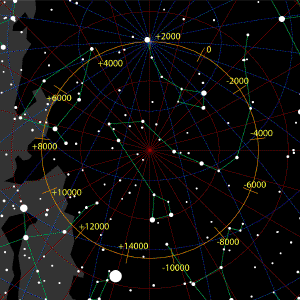Post
As the World Turns
9 October 2012
If you look up in the night sky in the northern hemisphere, you might notice that the stars seem to rotate around a single star, known as Polaris. Polaris isn’t a particularly bright star, but it is easy to see on a clear dark night, and it just happens to be above the north pole of Earth. So as the Earth rotates on its axis, Polaris seems to stay in a single spot while the other stars appear to circle around it.
It can be quite useful to have a stationary star in the sky, particularly when trying to navigate the open oceans without modern tools such as GPS. So Polaris is a happy coincidence. Of course, Polaris hasn’t always been the north star, nor will it be for long (on an astronomical scale).
In 3000 BCE, the north star was actually Thuban, in the constellation of Draco. In about 12,000 years from now, Vega will be the brightest “pole star”. The reason for this change over time is due to an effect known as precession.
 Wikipedia user Tauʻolunga
Wikipedia user TauʻolungaIf you’ve ever watched a spinning top, you’ll notice that it not only spins on its axis, but that orientation of the axis slowly wobbles in a circle. The reason for this is that gravity is trying to tip the top over, but can’t because of the rotation of the top. Instead of falling over the top changes orientation, which is known as precession.
For the Earth the effect is similar. The Moon and Sun try to twist the Earth’s axis up from its 23 degree inclination, and the Earth responds by precessing its axis. As a result our north star changes over the millennia. For most of history, there won’t really be a visible north star (just as those in the Southern Hemisphere don’t have a “south star”).
So the next time you find Polaris in the night sky, you’ll know it’s the one star that stays put as the world turns… for now.